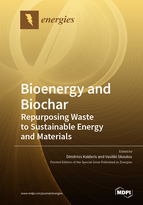Bioenergy and Biochar: Repurposing Waste to Sustainable Energy and Materials
A special issue of Energies (ISSN 1996-1073). This special issue belongs to the section "D1: Advanced Energy Materials".
Deadline for manuscript submissions: closed (30 September 2020) | Viewed by 55543
Special Issue Editors
Interests: biochar; hydrochar; carbon-based nanocomposite materials; hydrothermal carbonization; biomass utilization for the production of added-value materials
Special Issues, Collections and Topics in MDPI journals
Interests: biomass waste/other waste characterisation, pre-treatments and alternative ways of exploitation; thermochemical treatments (carbonization-torrefaction-pyrolysis-gasification-combustion) of food-woody biomass waste, fossil fuels and other waste for waste to energy (WtE), bioenergy-biofuels, biochar production; bioenergy/solid-gaseous biofuels systems design/repurposing of existing technologies to adapt new types of waste to fuels/feedstock; advanced cycles and alternative processes for biomass, fossil fuels and waste exploitation for biofuels-bioenergy-biochars under the circular economy scenario; combined renewable energy sources (RES) energy production systems, emphasized in lignocellulosic biomass/other waste sources for net zero carbon centralised and decentralized solutions; 2nd, 3rd and 4th generation feedstock for biofuels production; biorefineries/waste-refineries and integration of thermochemical and biochemical processing routes of biomass/waste; artificial intelligence (AI)
Special Issues, Collections and Topics in MDPI journals
Special Issue Information
Dear Colleagues,
All types of biomass, and their waste, comprised one the pillars of the pre-industrial, pre-fossil fuel, agriculture-based economies of the past. Traditional practices of biomass waste management were applied, but not necessarily in a sophisticated and efficient way, and covered all the way up from agricultural activities to food production, animal feed, natural fibre separation as well as processing of forest-wood. The modern bioeconomy sector, though, includes new circular economy energy and materials streams of added value products, such as gaseous, liquid and solid biofuels and bioenergy generation routes, and biochar production, along with all the previously mentioned traditional bioeconomy emerged products.
The aim of this Special Issue is to include the latest bioenergy and biochar advancements and incorporation to a bioeconomy in transition. This Special Issue focuses on nature, properties, upgrading and bioenergy generation processes from all types of biomass waste and biochars originating from biomass waste. Overviews of international ongoing and collaborative, transdisciplinary research projects, technology transfer and policy development in the field are also welcome. A transdisciplinary approach in order to examine, explore and critically engage with issues, advances and barriers of the attempt are also encouraged.
Dr. Dimitrios Kalderis
Guest Editor
Dr. Vasiliki Skoulou
co-Guest Editor
Manuscript Submission Information
Manuscripts should be submitted online at www.mdpi.com by registering and logging in to this website. Once you are registered, click here to go to the submission form. Manuscripts can be submitted until the deadline. All submissions that pass pre-check are peer-reviewed. Accepted papers will be published continuously in the journal (as soon as accepted) and will be listed together on the special issue website. Research articles, review articles as well as short communications are invited. For planned papers, a title and short abstract (about 100 words) can be sent to the Editorial Office for announcement on this website.
Submitted manuscripts should not have been published previously, nor be under consideration for publication elsewhere (except conference proceedings papers). All manuscripts are thoroughly refereed through a single-blind peer-review process. A guide for authors and other relevant information for submission of manuscripts is available on the Instructions for Authors page. Energies is an international peer-reviewed open access semimonthly journal published by MDPI.
Please visit the Instructions for Authors page before submitting a manuscript. The Article Processing Charge (APC) for publication in this open access journal is 2600 CHF (Swiss Francs). Submitted papers should be well formatted and use good English. Authors may use MDPI's English editing service prior to publication or during author revisions.
Keywords
- biochar
- hydrochar
- combustion
- pyrolysis
- gasification
- activated carbons
- biomass waste
- agricultural residues
- circular bioeconomy
- carbon sequestration
- bio-refinery







